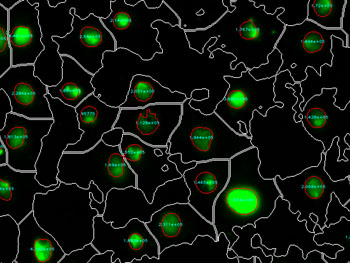First High-Throughput Imaging Platform for Predicting Kidney Toxicity of Chemicals
By LabMedica International staff writers
Posted on 27 Jan 2016
Researchers have developed a high-throughput platform of automated cellular imaging that efficiently and accurately predicts renal toxicity of chemical compounds without animal testing, providing an improved approach to development of safer medicines and other chemical products.Posted on 27 Jan 2016
Researchers at A*STAR’s (Agency for Science, Technology and Research) Bioinformatics Institute (BII; Singapore) and Institute of Bioengineering and Nanotechnology (IBN; Singapore) developed the platform based on an approach combining cell culture, imaging, and computational methods. The system could prove invaluable to pharmaceutical companies as well as companies in food, nutrition, cosmetics, consumer care, environmental, and other chemical-dependent sectors.

Image: The “cellXpress” automated imaging analysis software enables to efficiently and accurately detect cellular responses (reflected in green) to nephrotoxic compounds (Photo courtesy of Agency for Science, Technology and Research (Singapore)).
About 20% of hospital or community acquired cases of acute kidney injury can be attributed to nephrotoxic drugs. Currently there is no accurate method for screening large numbers of potentially nephrotoxic compounds with diverse chemical structures. Existing approaches for predicting compound toxicity include animal testing, which involves ethical issues, high costs, and long turnaround times that result in low throughput, making it unsuitable for screening the increasing numbers of potentially nephrotoxic compounds used in products. Animal testing may also result in poor prediction of human toxicity due to interspecies differences. Other methods of nephrotoxicity screening are also slow, laborious, and costly, or may require prior knowledge of compound chemical structure or mechanism of action.
The researchers have been developing cell-based screening methods that address this critical need, particularly as animal testing bans for cosmetics have been implemented in the EU, Norway, India, and Israel, with many more countries expected to follow suit. They recently reported the first and only cell-based renal screening platforms that can predict nephrotoxicity with high accuracy. Improving on this, they have now developed an imaging-based method that can be used to test much larger numbers of compounds.
Dr. Lit-Hsin Loo, study coauthor and BII principal investigator, said “By automatically analyzing more than 25,000 microscopy images of cells treated with different compounds, we were able to identify phenotypic signatures of kidney cells that can be used to predict the in vivo toxicity of compounds with diverse structures and mechanisms, with a validated accuracy of 80%–90%.”
In this study, over 2 million individual cells were screened for reactions to over 40 different chemical compounds, including antibiotics, antivirals, chemotherapy drugs, and industrial and agricultural chemicals. Analysis was performed using “cellXpress”, an automated image analysis software developed by Dr. Loo’s team.
Coauthor Dr. Daniele Zink, IBN team leader and principal research scientist, added, “This novel software platform reduces the reliance on existing laborious and time-consuming methods currently available for testing of nephrotoxic compounds, enabling much faster predictions. We will continue to work together to improve and further validate the use of this approach, and hope that our work will help to make products safer for consumers and patients.”
The study, by Su R et al, was published online ahead of print November 27, 2015, in the journal Archives of Toxicology.
Related Links:
Institute of Bioengineering and Nanotechnology at A*STAR
Bioinformatics Institute at A*STAR




 assay.jpg)








